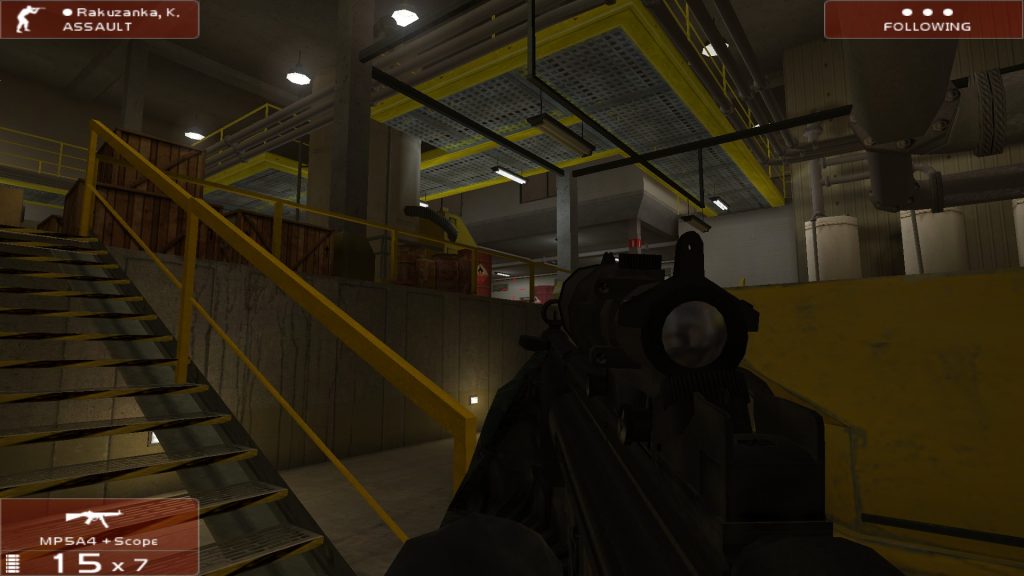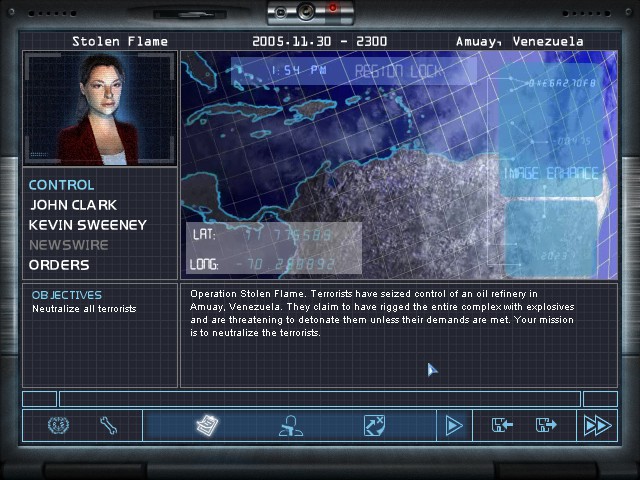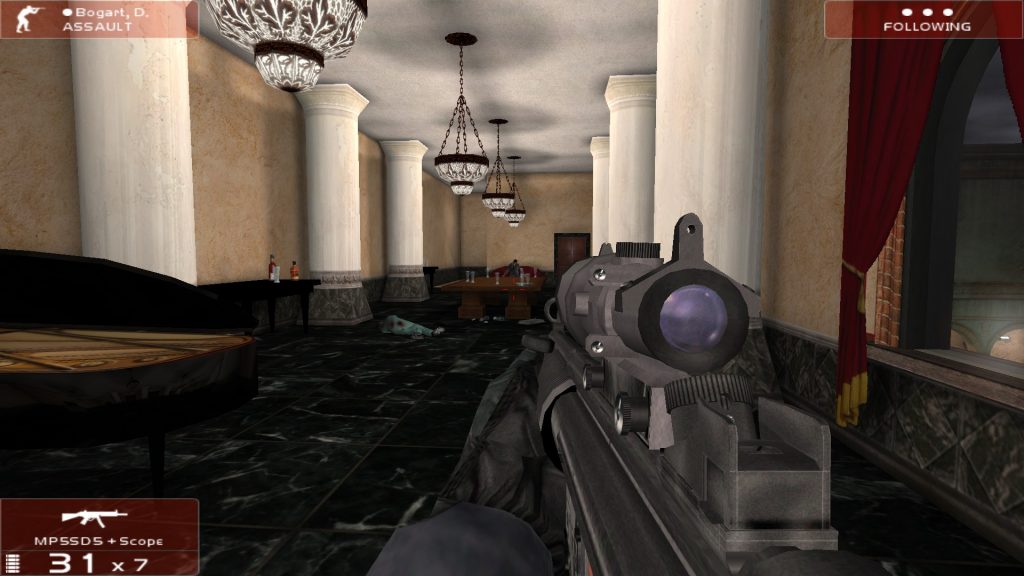The trouble with drawing a series in our Steam roulette is that it really puts a dent in my enthusiasm. There’s always so many games to review all at once. Sure, I could review them one at a time, but then I won’t really be able to compare them accurately. Then, because reviewing multiple games takes a lot of time, I put it off and just don’t play anything (well, except Android: Netrunner). So it went with Tom Clancy’s Rainbow Six. Finally, I got around to it; and right off the bat, Tom Clancy’s Rainbow Six seems to avoid many issues I have with FPSs – at least early on.
This overview is a bit of a rant, but it should provide some insight into my viewpoint on modern-day FPSs. There are three reasons that most FPSs were initially set in the WWI/WWII era, and they come down to gameplay, nationalism, and familiarity. Let’s attack these in reverse order. Perhaps the most obvious reason for the WWII setting is its familiarity: we haven’t had any large-scale wars since WWII, and the technology is similar enough to today that it doesn’t feel like too far in the past. Most importantly, it was the first large-scale war where we had significant film coverage and photographic records – making it easy to create a game that has the same feeling of the movies and pictures we have seen.
The nationalism argument is just as straightforward. Everybody can agree the Nazis were terrible. Hating the Nazis (or zombies – there’s a reason for Wolfenstein) is pretty much the most universally accepted thing in the world, and sympathizing with them the most universally reviled. What compounds this is the relative moral ambiguity of war since. Game publishers are going to publish games that don’t get bad press and can be enjoyed by as many people as possible. Though, since much of the market is American, you can see modern FPSs branch into the bold new territory of muscular white guys killing Russians or generic Middle-Eastern-looking-folk.
There is, I think, a third reason for the time period choice, and it has to do with the evolution of warfare. This is quite clearly not my specialty, but I hope these thoughts make sense. There was a brief – very brief – period of time where out-and-out war could be fought with guns by throwing the larger number of people at your enemy. Prior to the 20th century, guns were inaccurate. Wars were usually fought on open battlefields: during the American Revolution, the British complained that the Americans hid behind rocks and trees during battle, which was very unsportsmanlike. By the end of WWII, accuracy in firearms and the nuclear bomb practically guaranteed that traditional out-and-out warfare was at an end.
Before I get myself into too much trouble with the history of warfare, I’ll instead shift to how this lowered accuracy affects the game. No one wants to play a game where the weapon you use takes a full minute to reload and will only occasionally hit what you are aiming at. But at the other end of the spectrum, modern weaponry is deadly accurate and punishes any mistake with probable, immediate death. This doesn’t make for fun gameplay, as I’ve mentioned before. One way to combat this is the Call of Duty approach: to trivialize injury and death with regenerating health, quick respawns, frequent mission checkpoints. This makes for a very fast-paced game – but not one with which I have fun since the trivialization of death and realism are incompatible concepts. This style also lends itself far more to a selfish power fantasy since you have little motivation to rely on teammates. If I wanted combat fantasy/sci-fi, I’d play Halo: Combat Evolved.
The other path is the one followed by early Rainbow Six and America’s Army games. These games accept that death will be quick if you barge headfirst into an unknown situation. For America’s Army, you have one life per round. You either slow down and work as a team or you die. With Rainbow Six, you either slow down and work as a team or you die and restart the level. I appreciate this philosophy, but unfortunately it doesn’t have widespread appeal.
America’s Army
Okay – I know this isn’t the game I said I was reviewing. But it is free and fits the theme of the Rainbow Six games, and it is one of my favorite games from growing up. An entirely multiplayer experience (besides the training levels), you work with the other team members online (a surprising number of whom are actual military personnel) to work your way slowly through the level. Even better – the other team always appears as the enemy, while your team always appears as the US Army. I’m not sure why more multiplayer games don’t do this. Overall, this is an incredibly well-made, straightforward, and realistic military shooter. As the top Steam comment says: “It is sad when the U.S. Army makes a more engaging and fun shooter than most triple A studios.”
Tom Clancy’s Rainbow Six 3: Gold Edition and Athena Sword
I like this game – it’s a squad-based shooter that can be incredibly punishing, as your character has only two damage states: injured and dead. Injury always seems to take the form of an arrow to the knee, since the only limitation of injury is your walking speed. Beyond this, there are a few strange features to this game. For example, when you first start the game, you’ll be greeted by a remarkably complex mission screen.
From here, you can review the floorplan of the refinery you will be assaulting and set up an assault plan to clear out the facility. Admittedly, I barely touched this feature once I found the “Quick Play” because I didn’t really know what I was doing. I think the game would have benefited from a first few missions with a locked-in plan (which doesn’t really seem enforced in-mission), then letting you choose the details once you have the controls figured out.
The first unusual feature you will notice in-game is the automatic targeting. If your weapon is pointing at all in the general direction of the enemy (and you aren’t moving), you will hit them. This takes almost all the challenge out of aiming, but this isn’t entirely a bad thing since the controls are quite wonky and the AI is a little too good at aiming at you. Even once you master the controls (which I didn’t quite do in my hour with the game), you’ll likely be surprised by the next feature: when you die, you switch to the next member of your team automatically (somewhat like the original Star Wars Battlefront). If you finish a mission in this manner, you’ll get a screen at the end telling you about the team member who was injured or died.
Because of these features, I fell into the same trap I had with Dishonored: I didn’t want to finish the mission unless I did it perfectly. In my hour, I only ever got to the second mission because of this. Still, there is a lot of meat to this game and I definitely see myself playing it at some point. For that, it goes into Tier Two.
Tom Clancy’s Rainbow Six: Lockdown
Besides a graphical upgrade, this iteration of Rainbow Six has a few important changes. Gone is automatic targeting – which is okay, because the controls are a lot more usable. Gone also is teammate-switching upon death. I think this detracts a bit from the squad-based feel, but it does encourage more cautious gameplay. What makes up for this is the permanent death of your squad-mates between missions. If you lose health or a teammate, that health is gone in the next stage of the mission and the teammate remains dead – no replacements in-mission. There is no healing, but you do have three damage states. Each time you take too much damage in a given period of time, you lose a health bar. I think this is a fair balance between completely regenerating health and needing to have health packs every few feet.
I think this is the high point of the series (as far as the games I own go), except for one unforgivable problem: the remarkably bad AI. Your teammates stand in very bad spots while getting gunned down by clearly visible enemies, and I tended to get 75% of the kills – which I think goes against the squad-based nature of the game. The enemies will stand around slack-jawed while you run up and kill them. It goes to Tier Two since I’d rather just play America’s Army against real people (or ARMA, since it too is on my “unplayed” list).
Tom Clancy’s Rainbow Six: Vegas and Vegas 2
If Lockdown was the high point of the series, I feel as if Vegas is the most disappointing. I’m sure I am missing a few games in between Lockdown and Vegas, since so much of the charm and draw of the series has been sapped away. You have infinitely regenerating health. You can take more bullets than your entire squad could in Athena Sword. You fight alone as some sort of power-fantasy vigilante. I don’t have any screenshots because that was disabled as well. I couldn’t force myself through the first mission after all this disappointment. I uninstalled the game, having not completed my hour. Tier Three.
This doesn’t apply to any specific game of the series, but I also noticed a general trend of less diversity as I played the later games. In the original few, you could switch between any of your teammates and those teammates could be of either sex or from a variety of countries. In Lockdown, your teammates still have diversity, but you aren’t allowed to switch to them. In Vegas, your female teammates seem to be relegated to ‘copter duty, and your teammates have become generic ‘Muricans (admittedly, with a token Japanese-American). Perhaps I’m being too harsh on this point since I only played an hour, but it was a noticeable change.
P.S. This review wasn’t great, but I was never going to start writing again unless I cleared out this series. Hopefully look for more frequent impressions soon!


